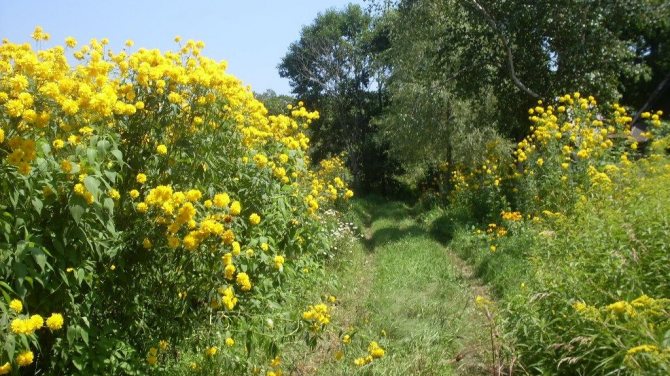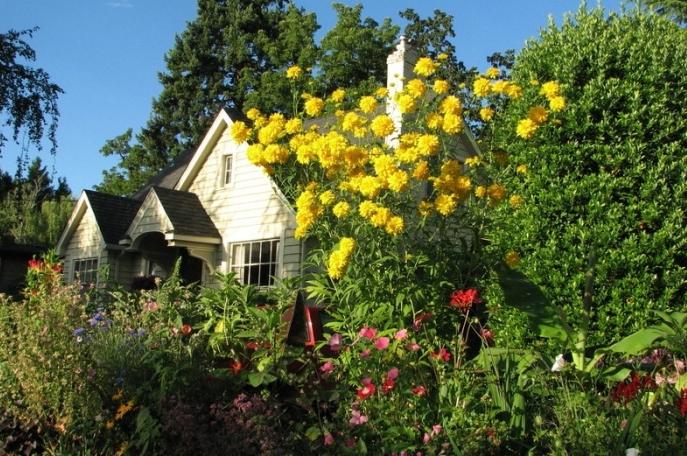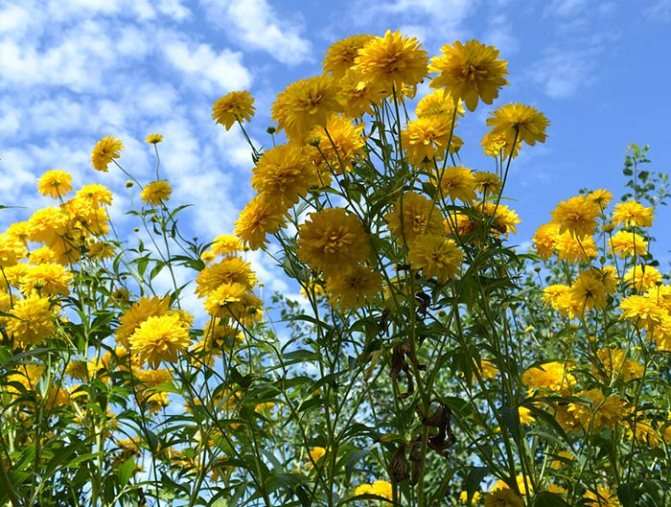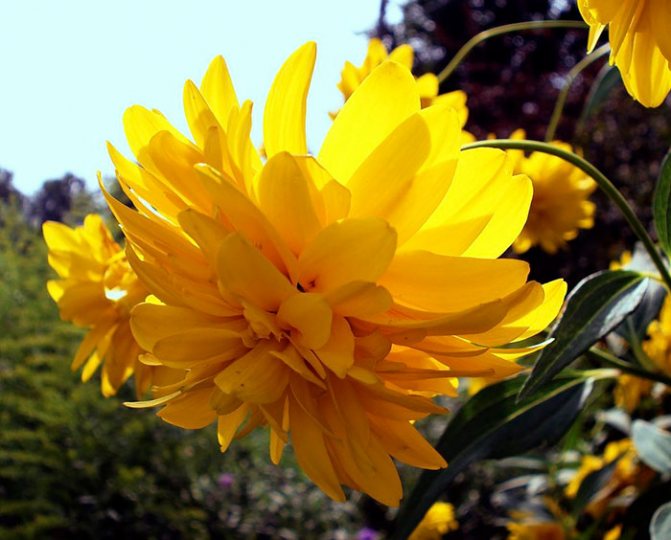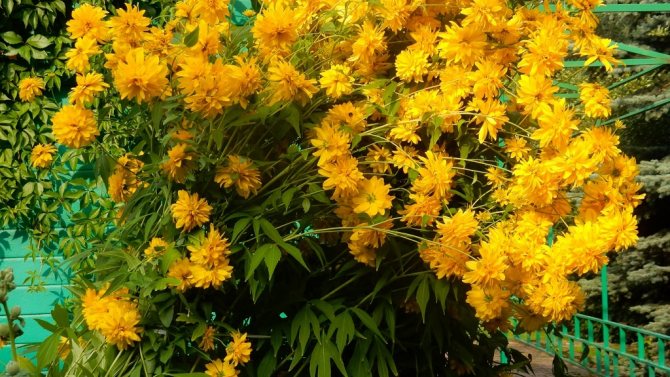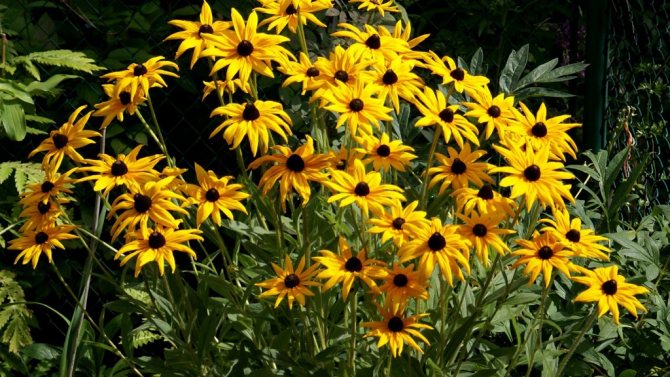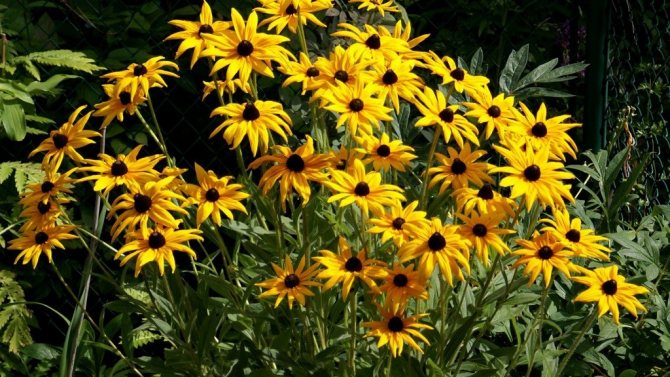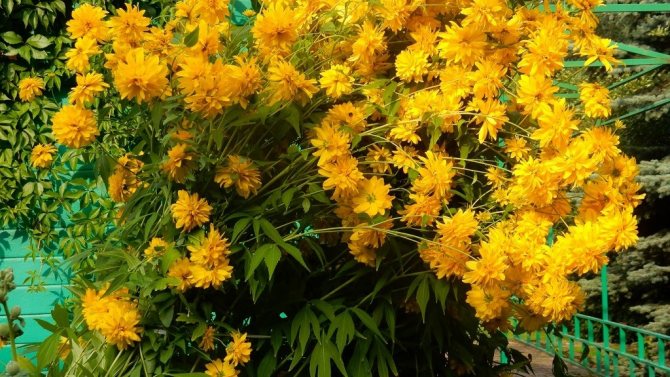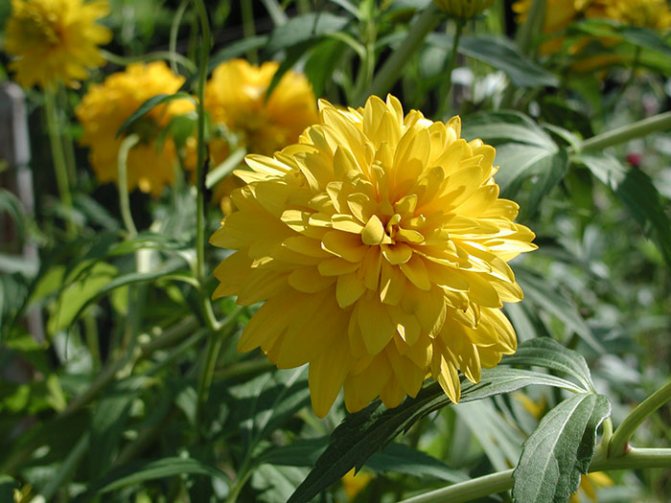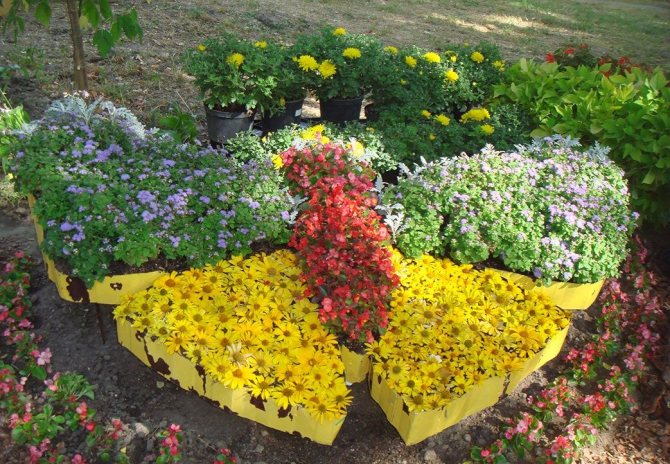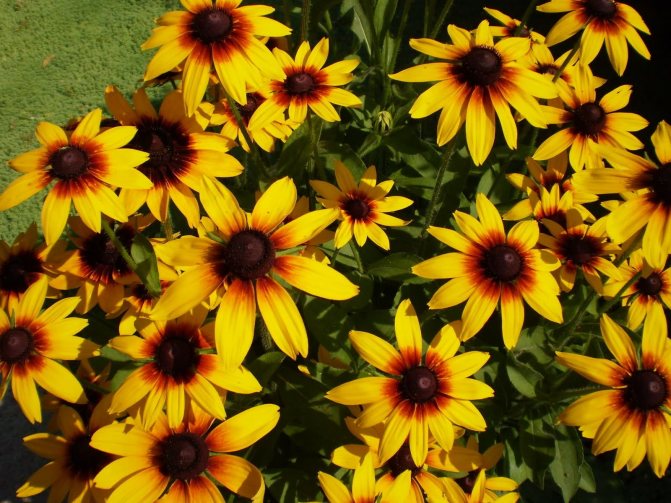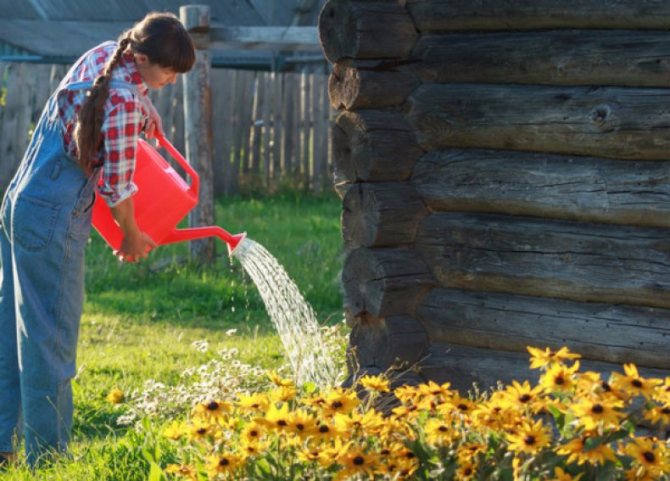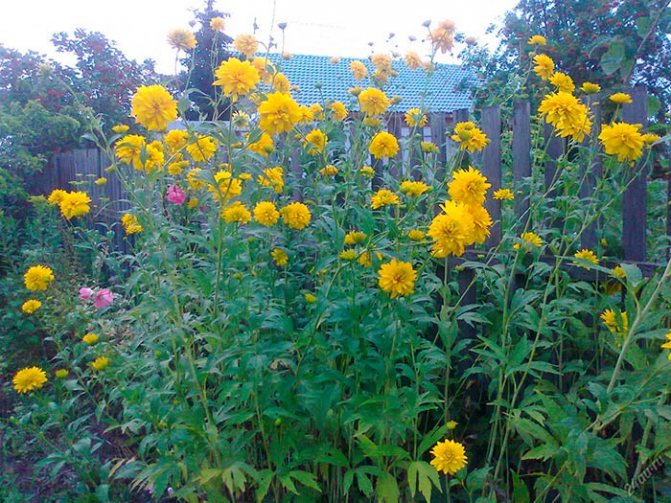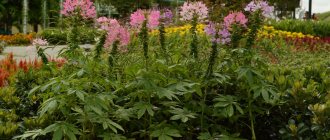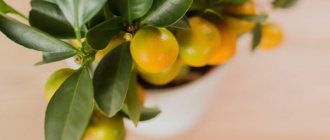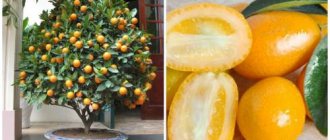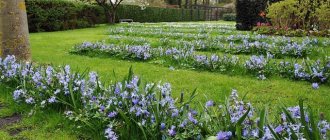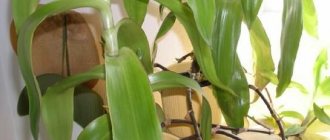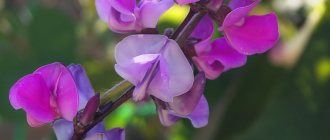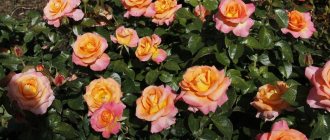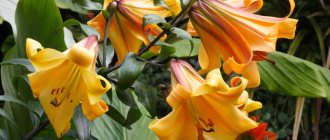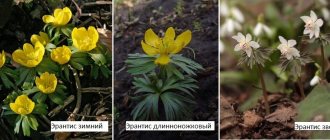to Dacha and garden 06/08/2018 1,
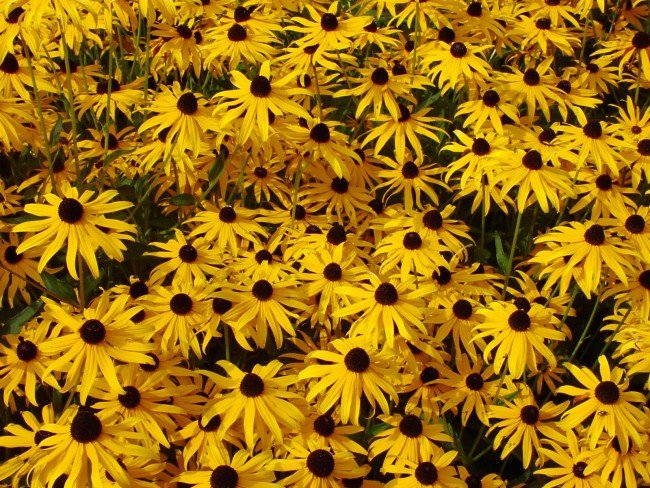
Rudbeckia very much looks like a chamomile, however, its difference from everyone's favorite flower in a juicy sunny yellow color
Rudbeckia is a dream plant for a busy summer resident, because caring for it does not take much time and effort, and she herself is rather lenient towards possible mistakes. It is a very tall (many varieties can reach up to 1.5-2 in height) perennial flower with straight, branched stems, which are abundantly covered with dark green pinnately dissected leaves.
- Rudbeckia in landscape design
- Rudbeckia hairy
- Rudbeckia brilliant
- Rudbeckia dissected (split-leaved)
- Rudbeckia purpurea
- Perennial rudbeckia: planting, growing, care
Rudbeckia blooms profusely from mid-summer. Even though the summer is over, this does not bother Rudbeckia - it seems that all this time she was preparing for her bright and memorable final performance. Until the first cold weather, the "Golden Ball" fills the garden with the golden radiance of its inflorescences-baskets.
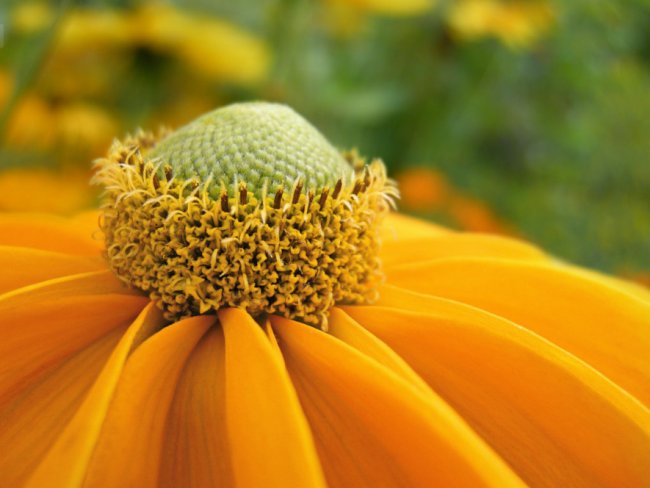

The flower is unusually bright and attracts attention
Rudbeckia golden ball in garden design
Rudbeckia dissected is planted in flower beds, the assortment of which does not change from year to year. Its powerful root system is able to grow rapidly without giving a chance to weeds. But this feature is not always acceptable, therefore, to limit the spread of the golden ball, a metal or plastic border is used, which is dug into the soil.
One of the advantages of the golden ball is its habit, therefore the plant is used to disguise unattractive outbuildings and fences, as well as to create a background for less tall stands. For example, in a mixborder, a gold ball is used in the background or as an intermediate plant between deciduous trees and the main part of the flower garden.
Golden balls look beautiful near any decorative architectural structure: a gazebo, pergola, well. They can also be planted by the porch, near the gate. Solid plantings of the golden ball are grown as a summer hedge for garden zoning.
Combining Golden Balls with other types of plants
As we have already found out, rudbeckia are perennial plants. The planted rudbeckia will please the eye for a single year, therefore, it is necessary to plant rudbeckia where you do not renew the plants annually. Rudbeckia is a very beautiful flower, it is well suited for planting next to fences or walls of the house. Also rudbeckia will look beautiful next to gazebos and recreation areas, harmoniously combined with tall plants.
If you plant it on your site, where it is windy enough, then it is worth fixing the stems of tall varieties. Rudbeckia emphasize all their beauty in combination with bouquet flowers, adding a certain charm to them. After cutting, rudbeckia flowers will delight for a week or more. Rudbeckia is an excellent option for those who are just starting to try themselves in gardening or simply do not want to spend a lot of effort on caring for plants, but at the same time want to have a beautiful bright area.
Golden balls bloom for a long time, and it is extremely easy to grow them, so it is not surprising that this flower is so popular among gardeners.
Features of rudbeckia golden ball
The popularity of golden balls is largely due to the duration of flowering, which lasts from early July until the onset of autumn frosts.Both a single flower and a plant as a whole bloom for a long time, constantly releasing new buds. Cut flowers also stand for a very long time.
Of the advantages, one can also single out resistance to diseases and pests. Rudbeckia dissected does not attract insects, except for plant pollinators, and is not susceptible to fungal and other diseases.
The disadvantage of the variety is the instability of the stems. Under the weight of inflorescences, foliage and their own weight, they lean, the bush falls apart and requires a garter. Breeders solved this problem by developing a new variety, the height of the shoots of which is only 80 cm. It is called a gold source (Gold guelle) and is distinguished by the compactness of the bushes, as well as abundant and long flowering.
Description: varieties and varieties of rudbeckia
Rudbeckia is a genus of flowering plants discovered by Karl Linnaeus. These flowers were brought to Europe from across the Atlantic. In the wild, the culture has several types:
- dissected;
- hairy;
- shiny;
- glossy.
The rudbeckia is dissected and became the basis for the most popular decorative variety Goldball or Golden Ball.
This is a perennial plant with a height of about 2-2.5 m.How it looks can be seen in the photo:
- Leaves are strongly dissected, green in color.
- Inflorescences are dense, spherical, about 10 cm in diameter. Consist of tubular petals in the center and reed petals around.
- Terry flowers. The color is bright yellow.
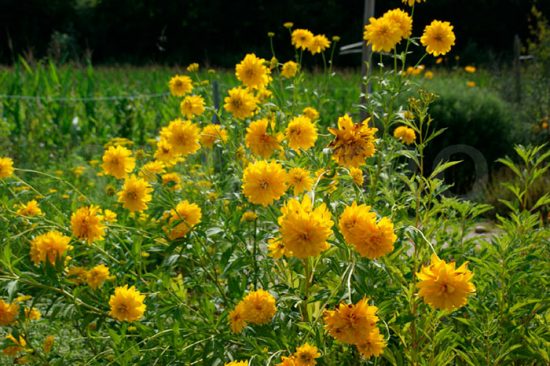

Perennial rudbeckia
There is another variety - Goldquelle, which is also popularly called the Golden Ball. Its difference is in height: a herbaceous plant grows only up to 0.8-0.9 m. Breeders have eliminated a significant drawback of the Goldball variety - the tendency of tall shoots to deviate in different directions under the weight of inflorescences. This feature harms the beauty of a flower bed or flower garden.
Reproduction of rudbeckia dissected
Two methods of propagation of rudbeckia golden balls are used: rhizome and seeds. It is easiest to dig out a part of the root in the spring and transplant it to a new place, therefore this method is used most often.
Rudbeckia is grown from seeds when it is impossible to obtain planting material. In March, the seeds are sown in boxes with a moist substrate, which, after emergence, are moved to a sunny windowsill. The soil during the cultivation of seedlings is maintained in a moderately moist state, and when the air is dry, the plants are sprayed from a spray bottle. When the air temperature outside the window is about 150C, the cut rudbeckia seedlings are hardened in the open air.
Interesting. Under favorable weather conditions, rudbeckia reproduces by self-seeding. Shoots that have grown from seeds that have fallen to the ground are dug up and planted in a permanent place.
Rudbeckia hairy
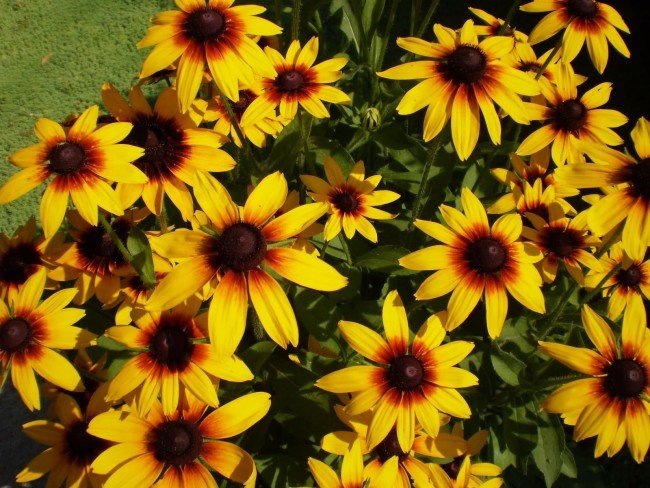

Another name is Gloriosa Daisy or Hirta rudbeckia, its flowers up to 7 cm in diameter have a dark clear center, which is surrounded by orange, yellow or brown-red petals. This variety belongs to short-lived perennials, although in landscape design it is used as an annual, because it is in the first year of the plant's life that the most abundant and spectacular flowering occurs, which loses its attractiveness with age.
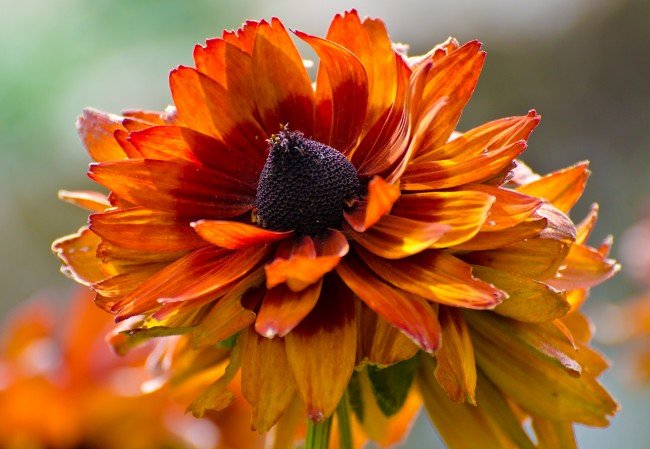

Rudbeckia - represented by a wide variety of varieties
Hairy rudbeckia is very hardy, it develops well on almost any soil and reproduces well by self-seeding, therefore it can “occupy” all free space. Drought tolerant, does not require frequent watering, but needs good sunlight. Flowering begins in mid-summer and lasts until mid-autumn.
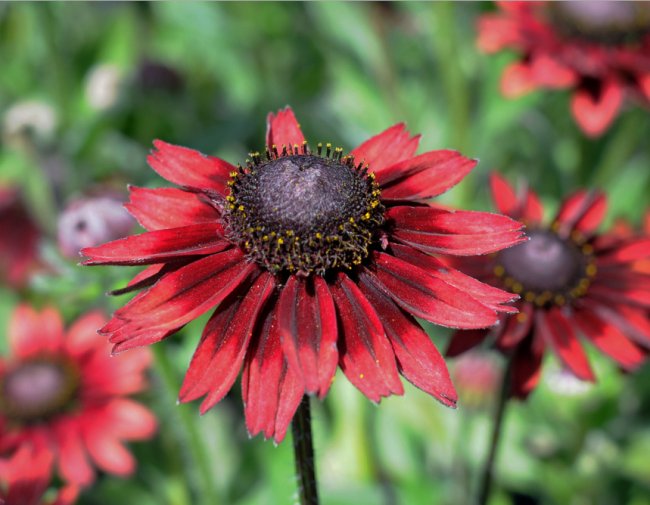

The variety "Cherry Brandy" is considered one of the most unusual, as its flowers are cherry-colored and almost black in the middle.
A distinctive feature of the hairy rudbeckia variety - Cherry Brandy - is an unusual color of flowers - cherry, with an almost completely black center. For planting Cherry Brandy, a well-lit area of fertile land is selected, and before sowing, a little lime is added to the ground.
Planting rudbeckia golden balls
Rudbeckia grows in sunlit or slightly shaded areas. The plant is not pretentious to the composition of the soil, but before planting, the soil must be dug well, weed residues must be removed, and rotted compost must be added to the poor soil. The dug area is well leveled with a rake, holes are made in the soil at a distance of 40 cm from one another and watered. The seedlings in the box are also watered, plants with a lump on the roots are taken out with a narrow spatula, and one seedling is placed in each hole.
Planting by dividing the bush is carried out in April, when the first shoots appear from the soil. With the help of a sharp shovel, a part of the root with several shoots is separated, and together with a lump of earth is placed in a hole poured with water. The remaining empty space is covered with earth.
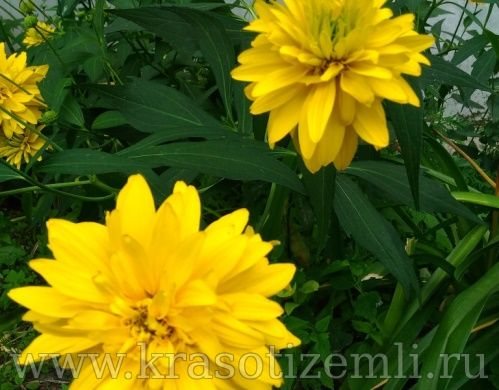

Rudbeckia brilliant
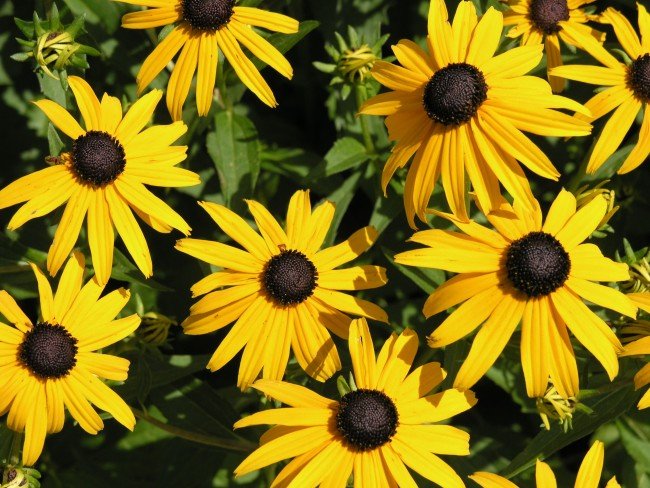

It owes its name to its shiny leaves. This abundant and incredibly lush plant with large, up to 10 cm in diameter, bright yellow flowers, can reach a height of up to 120 cm, which is why it is often called the Golden Tower. This rudbeckia is perennial, it winters well in the soil in our climate, it is very unpretentious, it prefers moist, but not swampy soils. Flowering occurs in late July - early August, at the beginning the flowers are bright orange, but towards autumn they acquire a reddish-brown hue. Propagated by dividing the rhizome or using seeds.
Gold Balloon Care
Rudbeckia is drought-resistant and tolerates hot weather well, therefore watering is rarely carried out, only in dry seasons. Seedlings planted in open ground and transplanted parts of plants need abundant watering.
The flower garden is renewed every 5 years. Old bushes are separated, excess shoots, thickening plantings, are removed. During this procedure, organic fertilizers are applied, thanks to which the plants become stronger and resume growth.
In October, the flower stalks lose their decorative effect, so they are cut off at a distance of 10 cm from the soil surface. Adult rudbeckia bushes easily tolerate the most severe frosts under a cover of snow, and young plants are additionally covered with spruce branches.
In the spring, as soon as the sun warms the soil, new shoots appear. Minimal care will give its results: many large bright yellow inflorescences will appear on the bushes.
Read also: Types and varieties of peonies with a description
Care rules
- Watering is done only in dry times. It is enough to water once every 3 days.
- After rain, leaves and inflorescences are freed from water residues. Since under its weight the plant can break.
- Before flowering, it is worth adding organic and mineral fertilizers, only in small quantities.
- Apply the second dressing in the fall, for example: agriculture or kemira.
- Faded buds need pruning. This makes it possible for new buds to appear.
- In the fall, the plants are pruned, leaving 15 cm above the ground.
- During the same period, the soil is mulched with sawdust or compost.
- Rudbeckia affects nematodes. Symptoms of infestation: Leaves that are cut through, fall off over time. Insecticides will help fight parasites.
- Once every 5 years, plantings are thinned out. Old bushes and excess growth are removed.
- During flowering, golden balls need to be tied to vertical supports.
- Periodically free the plant from weeds.
Botanical description of the species
Rudbeckia dissected belongs to perennial herbaceous plants, the height of which can reach three meters. However, most often there are bushes, the average height of which is 70 cm... They have a fibrous root system and a highly branched horizontal rhizome. It often promotes the formation of plant colonies.
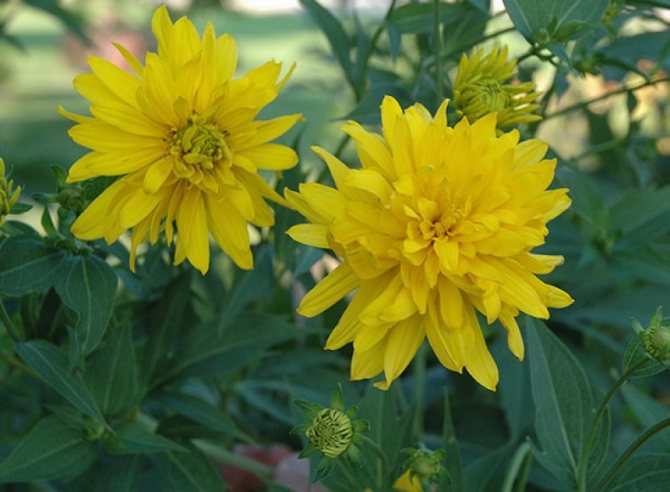

The foliage has a dark green color, there are practically no hairs on it. Its lower part is pale green in color, has a moderate "hairiness".
A simple or complex umbrella is present at the end of the stem.The inflorescences are represented by large baskets, the diameter of which is about 10 cm. The receptacle is convex, after a while it acquires cylindrical outlines and sharp bracts. Barren reed flower has a bright yellow or orange color.
The flowering period begins in July and ends in mid-October. The fruit is represented by an elongated seed with a crown of fine teeth.
Recommendations from experienced summer residents
The rudbeckia variety dissected by Goldquelle is an unpretentious flower, so even people with no knowledge of gardening can grow it. But in order for the plant to please the eyes for a long time, the following recommendations should be adhered to:
- Do not overdo it with fertilizers. The Golden Ball should be fed only 2 times per season, and a minimum amount of fertilizer should be applied.
- It is advisable to replant rudbeckia every 3 years.
- The golden ball is very tall, so it is undesirable to plant short flowers next to it. Because of the shadow, they simply won't rise.
- Rotten and spoiled branches, leaves must be removed immediately. They can lead to damage to the entire bush.
- For the winter, the plant is best covered with polyethylene.
Goldkwelle is one of the varieties of rudbeckia. Flowers Golden balls are perennials, but they need to be planted every 3 years. As with other types of rudbeckia, it is not necessary to constantly care for it; care is reduced to infrequent watering and removal of weeds. Sometimes it will be necessary to feed the plant and remove the spoiled leaves. Goldquelle tolerates winter well, but severe frosts can damage the root system, and then the plant will begin to bloom only by the end of summer. To avoid this, the bushes need to be cut and covered for the winter.
Plant "Green ball"Has gained its popularity for its unpretentious cultivation and long flowering.
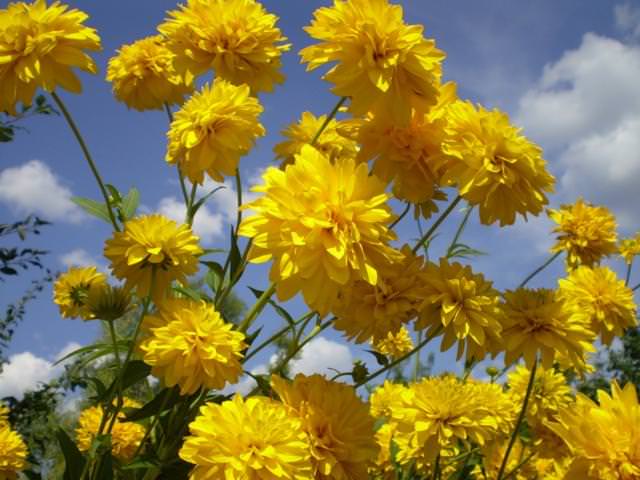

The best place to plant
Before planting flowers yellow balls, you need to figure out where the plant will feel better.
Lighting and location
Despite the fact that rudbeckia prefers open, sunny areas, it will be able to grow normally in a not very shaded place. Ideally, if the area where you plan to plant the flower will be illuminated by the sun for 6-7 hours a day.
The flower is not particularly picky about the soil, but it will feel much better in a nutritious, light soil. If you plan to plant in clay soil, you need to mix it with sand and compost, add ash and sawdust. It is important that the soil is rich in nutrients - if they are not enough, it is worth fertilizing it with humus, peat or compost.
Rudbeckia purpurea
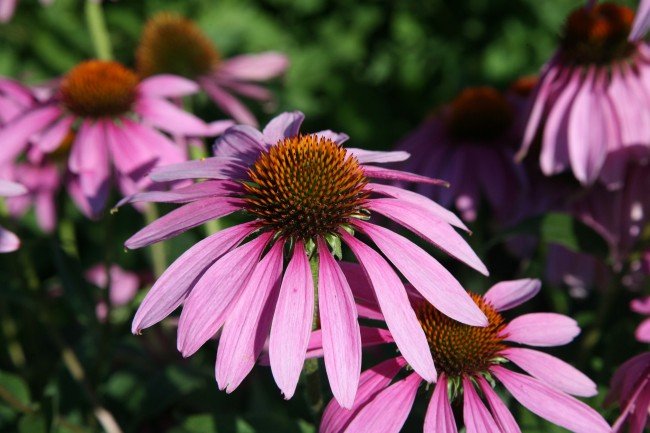

A cold-resistant, light-loving plant, the height of the stems can reach 90 cm, the flowers in shape and color can be confused with chamomile. Reproduction is carried out both with the help of seeds and by dividing the rhizome.
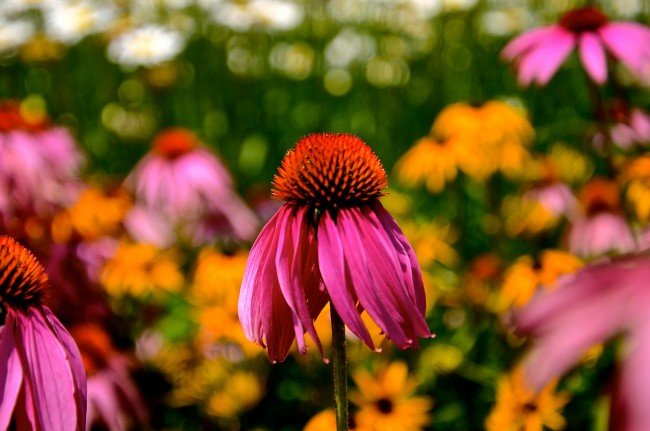

Some sources combine this genus with the closely related genus Echinacea.
Landing rules
If you decide to plant golden balls in your area, it is important to know how to plant and care for this plant correctly. Consider in what ways you can plant rudbeckia.
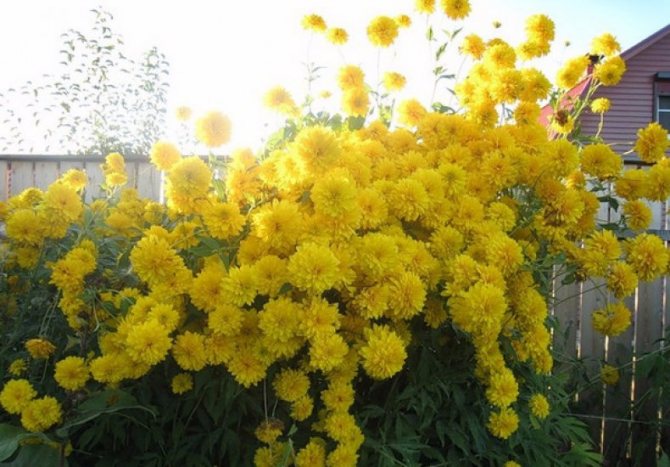

Seedling method
Reproduction of the golden ball using this method is best done late March - early April. First, the seeds are sown in special boxes for seedlings, sprinkle them a little with earth on top and moisten them with a sprayer.
The containers must be covered with foil and left in a room with a temperature of 20-22 ° C. After 10-14 days, you can see the first shoots. During this time, it is important to moisten the ground a little, to air the crops.
When the first two pairs of leaves appear on the seedlings, they are planted, providing them with space. After they are taken, they are hardened - taken out to the balcony daily for a couple of hours.
If the air temperature is already quite high, the flower will take root quickly, but if the nights are still cool, it is recommended to cover the seedlings with agrospan until they start. Rudbeckia can grow in one place for up to 5 years, so if you do not plan to replant it, mulch the area with 8 cm of compost.
Direct seeding
Sowing by seed is usually carried out in June. The advantages of this method include the fact that planting is carried out directly into the ground, so there is no need to waste time growing seedlings. And the disadvantages of seed sowing is that rudbeckia bloom will come only next season.
The sowing principle is very similar to growing seedlings. It is necessary to make small grooves in the soil, put seeds in them and lightly sprinkle with earth. After that, the bed is gently watered. The first shoots should hatch in about 10-14 days. After the emergence of seedlings, it is necessary to properly care for the plant, and we will tell you how to do this in the next section.
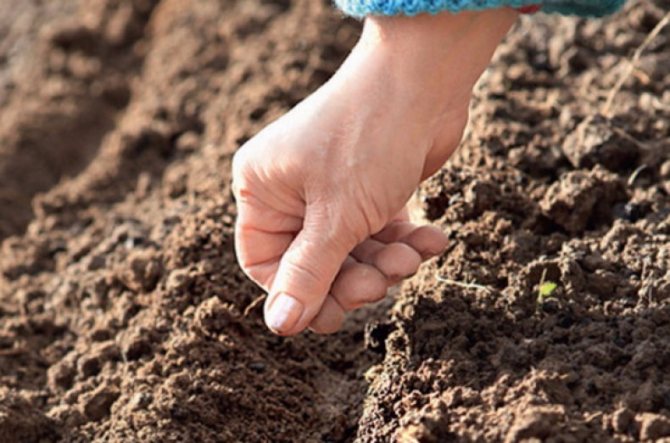

Flower characteristics and planting features
The dissected rudbeckia is quite resistant to a sharp drop in temperature. Therefore, it blooms until the very end of autumn. It is also resistant to many types of diseases. In addition, it is extremely rarely exposed to pests.
Flower propagation is carried out by seed or seedling.
Seed planting:
- You need to collect peat and sand in the container. The contents of the container must first be leveled and only then filled with seeds. Then the seeds need to be lightly covered with earth. The seed is small, and if you overdo it with the soil, it will not germinate.
- After that, the container needs to be covered with a film and placed in a place where sunlight constantly gets in, the temperature there should not be lower than 18 degrees. Then watering is required on time. Watering should be done from a spray bottle, so weak sprouts will not be damaged.
- A few days after planting, the film will need to be opened every day for 10-15 minutes. After 21 days, the film is completely removed.
- When the sprouts get stronger and the weather settles, the seedlings are planted in open ground.
It is best to plant the bushes in springtime, in warm and dry weather. Therefore, mid-May is considered the ideal time for breeding rudbeckia. Seedlings are planted in shallow holes, far from each other (the distance between two holes should be at least 30 cm).
Perennial flower care
If you want golden balloons flowers to delight you with their beauty, you must to properly cultivate and care for them:
- Watering.
The flower does not need frequent and abundant watering; rain irrigation is also enough for it. However, if the weather is dry for a long time, it is still worth moistening the soil every 3-4 days. After rain, it is necessary to ensure that no water remains on the leaves, since under its weight the plant can break.
- Top dressing
... It is recommended to feed the flower annually. However, do not add too large doses - limit yourself to the minimum amount of organic and mineral substances. Mineral dressing should be applied at the root of the plant. - Pruning
... In order to give the opportunity to develop new buds, it is necessary to periodically form the bush. In autumn, high stems are pruned, leaving only 15-20 cm above the ground. They also mulch the root system with compost and sawdust.
Read also: What else can you manage to plant in the garden in July?
As you can see, there are no special difficulties in caring for a flower; even an inexperienced florist can master it.
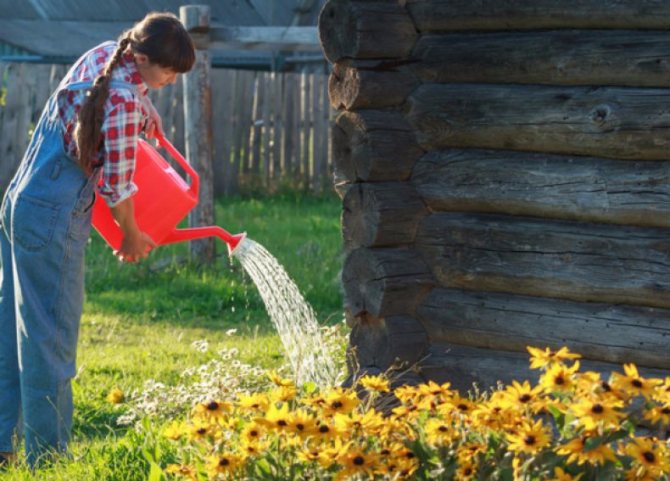

Agrotechnics
Flowers Golden balls are unpretentious, planting and care does not take much time.
Rudbeckia unpretentious plant
It is important to find a suitable place for growing rudbeckia. Although the plant is not capricious, it is better to plant it in an open and sunny place. It is also possible to plant it in a darkened place, but in such a place the flowers will be small and not so bright.The Golden Ball is also undemanding to the soil, but it is advisable to prepare the land before planting: fertilize and disinfect. Any organic fertilizer is suitable for soil enrichment. To disinfect the soil, you need to remove dried branches and leaves from the site, as well as weeds.
Important! If planting is carried out by seed, the soil in the container must first be held in the frost. This will prevent insect damage to the seeds.
After planting, it is imperative to mulch the area around the seedling. This way you can protect the roots of weak seedlings and maintain soil moisture.
After the seedlings are taken, you only need to water them and destroy the weeds. Often it is necessary to remove weeds until the plant grows, after which this procedure can be carried out much less often. You need to water the bush every 3-4 days.
Attention! It is undesirable to pour Goldquelle, as this variety of flowers does not tolerate strong humidity.
In June and July, the risk of infection of the plant with various diseases increases, and pests are also activated at this time. Therefore, during this period, the entire garden should be treated, even if there are no signs of infection. To do this, you can use the following tools:
- citrus bark,
- ash,
- potassium permanganate,
- herbal infusions, etc.
If a disease has been identified, the entire area should be immediately treated with a special agent.
Read also Datura flower when to plant
In the spring and during the period of abundant flowering, the plant should be fed. You need to apply a minimum amount of organic or mineral fertilizers.
Rudbeckia is a tall plant and requires care
In order for Goldkwell's rudbeckia to bloom even more abundantly, it will need to be pruned from time to time. A damaged leaf, faded flowers and broken stems also need to be removed. After removing all the excess power, the plants will be directed to flowering. In autumn, the bush should be cut to the root, then covered with a good layer of hay or straw. If this is not done, the plant may not bloom after a cold winter.
Plant pests and diseases
Flower is rarely affected by diseases, but sometimes it can be attacked by powdery mildew. It has the appearance of a white bloom on foliage and stems. To cure a flower, it is worth spraying, for which a one percent solution of colloidal sulfur or a solution of copper sulfate is used. The optimal proportion is 80 g per 10 liters of water.
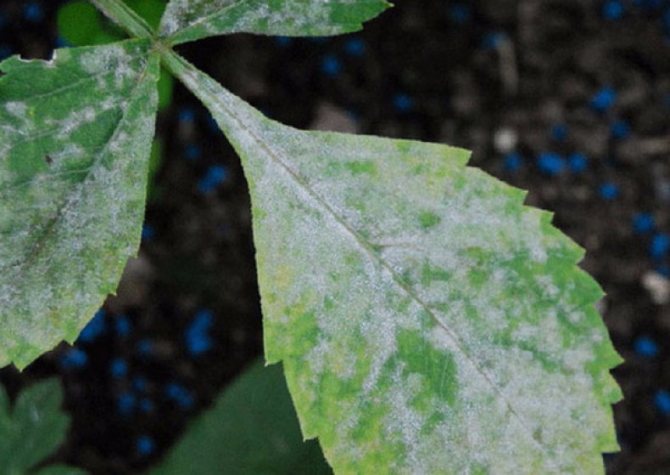

In rare cases, rudbeckia is attacked by a leaf nematode, which is characterized by brown spots on the foliage, leading to their thinning and death. Such drugs as Bazamid, Nemagon and Nemafom will help to cope with the misfortune. It must be used according to the instructions, while the affected areas of the flower are best removed and burned.
The flower is attacked by various pests, one of which is aphids. To prevent damage to the plant, it is necessary to carry out preventive treatment of the bushes with the help of special preparations.
Rudbeckia dissected or a golden ball is a beautiful plant that will harmoniously fit into any flower bed at a summer cottage. Thanks to its easy care, even beginner growers can plant it.
Care, fertilization and feeding of rudbeckia. Diseases and pests
Features of the care of the Golden Balls in the open field:
- Rudbeckia is considered a drought-resistant perennial. But in the heat it is better to increase the intensity of watering. Otherwise, the plant will lose its attractiveness.
- In November, after the end of flowering, cut off the entire aerial part, leaving 8-10 cm from the stems.
- In open ground, rudbeckia grows rapidly and can oppress neighboring crops. Consider this feature at the planting stage: dig a root barrier around the plants or pick a distant place.
- About once every 5 years, the flower needs to be thinned out. Delete whatever you see fit.
- The plant does without winter shelter.
Fertilizer under the golden ball is recommended to be applied twice a season:
- in May, before flowering;
- in late summer or early days of autumn.
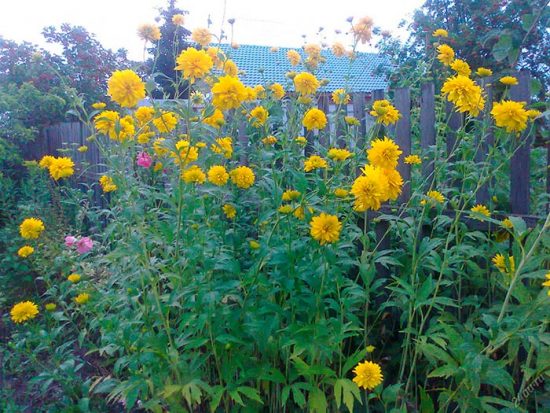

Rudbeckia grows well
Apply any mineral fertilizer to grow flowering plants. Top dressing will make the flowering more lush and vibrant.
Rudbeckia is completely resistant to pests and diseases. In a very neglected form, the plant can be affected by powdery mildew - a white bloom on greenery. Care in this case consists in spraying with liquid copper sulfate (8 g / l) or colloidal sulfur. Brown spots on foliage are a sign of leaf nematode infestation. In this case, spray the bushes with Bazamid or Nemaphos.
Fireworks of golden balls, or a few words in defense of the "grandmother's inheritance"
There is a flower, at the mention of which many designers and far too advanced florists wrinkle their nose contemptuously. In gardening literature, there are phrases like: "If you finally find the strength to part with your grandmother's inheritance in the form of golden balls and other low-value plants ..." Where did we get this from? Why is the irreplaceable, in my opinion, flower, indispensable (along with lilacs and phloxes) companion of the Russian garden began to be ostracized?


Rudbeckia dissected, golden balls - an indispensable part of the Russian garden
And you will find another equally joyful, unpretentious, long-blooming and, moreover, well-standing plant in the cut!
A symbol of neglect and slovenliness, they may tell me. But this is an oversight of the owner, and not the properties of the flower. Yes, high stems require a garter, and the appearance of the plant largely depends on how beautifully and neatly it is made. Put a beautiful support for the golden ball, without "squeezing" it like a sheaf with a piece of clothesline - and you will not recognize the old "Cinderella"! You can make an openwork "vase" (from rods or wire), and the "bouquet" will last for at least two months, especially if you remove the faded baskets.
Yes, this plant is sick with powdery mildew - why don't phloxes and perennial asters get sick? Is it possible for gardeners and designers in England to turn their backs on, say, cuffs and foxgloves, because they are outdated and ubiquitous? And what, the cuff does not have powdery mildew?
Disdainful attitude towards dissected rudbeckia, or split-leaved (Rudbeckia laciniata) is completely incomprehensible and has no justification other than our age-old denial of our own values for the sake of fickle "high fashion". Most foreign books on floriculture in the section on rudbeckia are certainly mentioned among the favorites. ‘Goldball’.
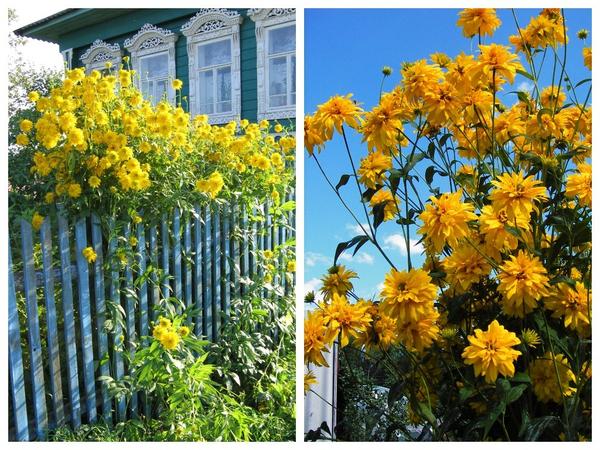

"Grandma's" golden balls adorn many modern gardens
In many Russian gardens, from June until frost, an honest golden ball covers unattractive fences, compost heaps, sheds. Here it grows in a conspicuous place - at the entrance to the site, next to a large spruce. Throughout the second half of summer and autumn, its inflorescences look even brighter against the background of needles.
You can position it behind dahlias, phlox harmonious shades. And what kind of "late" mixborder can be made by planting golden balls and another kind of rudbeckia in the background, two-meter R. glossy (R.nitida) along with heleniums, perennial asters, chrysanthemums different types and varieties. You will get an irresistible combination of yellow, golden brown, lilac blue, pink and white colors!
Read also: How to properly transplant a Decembrist at home
Just imagine that all gardeners have heeded the fashion trends. The sunny village front gardens will go out at once, the golden lights, which illuminated even the dark corners of the garden with gloomy autumn, will disappear. And no other flower can replace their faded light ... Let the shining fireworks of golden balls remain in our gardens!
Rudbeckia in landscape design
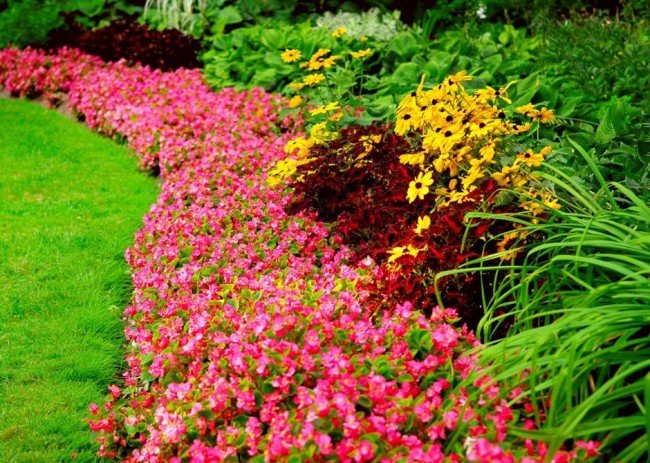

This herbaceous perennial has a successful career in landscaping for over a century.
Rudbeckia is simply irreplaceable when decorating a plot in a rural style, bright daisies will add carelessness and ease to the garden. It is used to create flower beds, as well as to decorate terraces, flower beds or balconies.It will look great both in a solitary planting and in a group, in addition, it is often planted in tubs or large pots for decorating balconies or terraces. In this case, her flowering begins earlier than when grown in the open field - the flowers bloom in June.
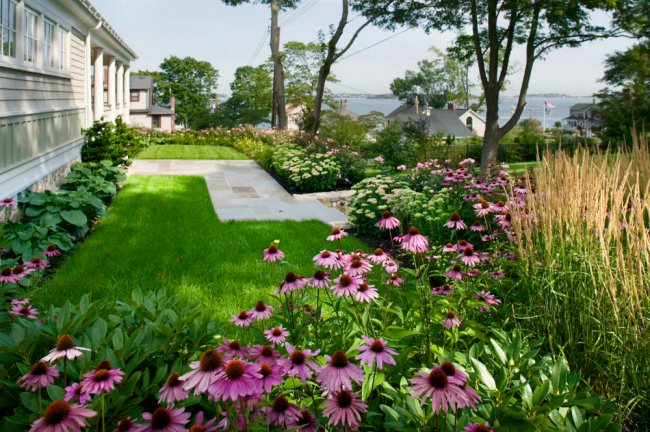

It looks decorative in individual flower beds, in the background of flower beds, in group and single plantings
High varieties and types of rudbeckia need support, so it is best to plant them on a site near fences (against the background of a shed or near a wattle fence) or in the background of a mixborder, where the garter to the support can be covered with other plants. For solitary plantings, it is better to choose low varieties that do not need a garter.
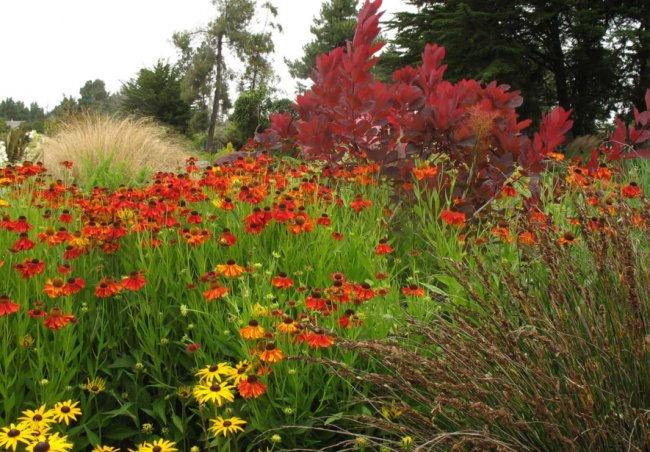

Many types of rudbeckia attract amateurs and professional flower growers to grow it at home - in the garden, in the country, in the apartment.
Advice! When planting rudbeckia in a flower bed, it should be remembered that it will gradually grow, forming dense thickets with bright yellow flowers, so it needs to leave enough space for growth.
Partner-neighbors for rudbeckia must be selected very carefully, because these bright and active flowers can overshadow other, more modest and less spectacular flowering plants growing nearby.
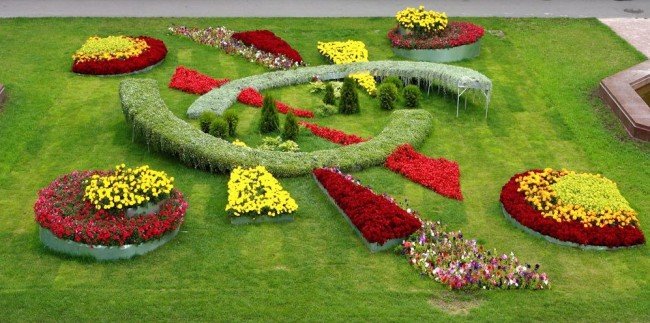

Best partners for rudbeckia: asters, coreopsis, delphinium, heliopsis, blue and white phlox
One-year verbena goes well with rudbeckia. If you plant it between rudbeckia bushes in May, you can get an amazing combination in which small purple dots will rise above the sea of yellow balls of bright rudbeckia. Other lush bright flowers or original greens: monarda, white phlox or blue sage will become good neighbors for rudbeckia. In the fall, chrysanthemums, asters, helenium or Gaillardia will look good with her. In the background, any other tall plants with large elongated inflorescences will be in place; a combination with grass carpets or ornamental grasses, for example, millet, reed grass or Chinese reeds, will also look unusual.
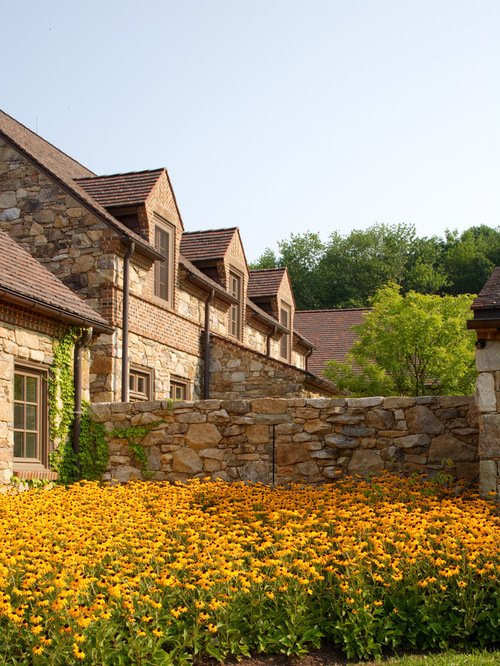

Tall varieties of flowers can be used to decorate buildings, fences and fences
A good neighborhood will turn out with cereals, which will give the composition an airiness, and the role of a bright accent will be played by rudbeckia flowers - this combination will look especially picturesque in an autumn garden.
Description and application of rudbeckia
The scientific name of the flower, popularly known as the golden ball, is rudbeckia and its homeland is North America, from where it was successfully brought to the territory of European continents only in the 17th century.
The flower itself is attributed to the Asteraceae family, being Compositae, and is a rather tall plant, reaching a height of more than 2 meters, unpretentious and rather hardy, perennial and giving on the bush a lot of golden color of large, double flowers.
The stem of the plant itself is straight, highly branching and very densely covered with pinnately dissected leaves that have bright green, saturated color. The rudbeckia plant itself gives many flowers, blooming profusely and long enough, when the latter resemble a golden ball, which is where its popular name comes from.
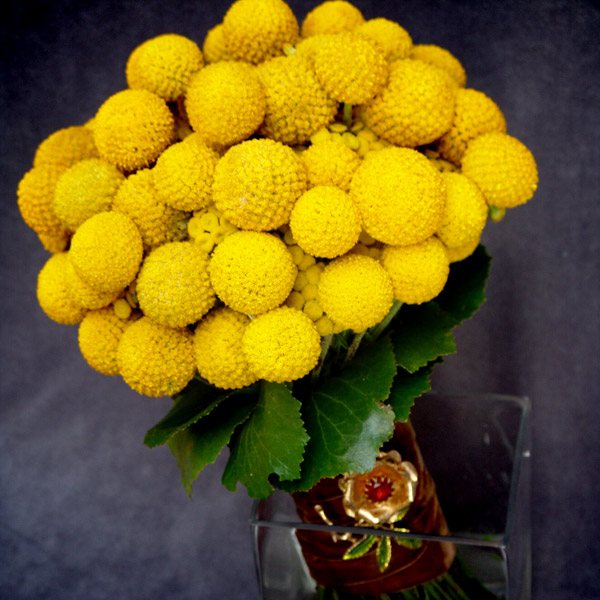

Its inflorescences are quite large in diameter and have a rich yellow color, although some varieties color them in purple shades and tones.
The flowering period is from mid-summer to the first autumn frosts, perfectly tolerating the rather harsh Russian winter and at the same time not needing shelter and insulation of the horse system for the winter.
Its flowers are in perfect harmony in the bouquet, and if we talk about how long this cut plant will stand in a vase, then more than a week. If the rudbeckia is not thinned out, its bushes can create real thickets, whole plantations of a dense forest of golden balls. The plant itself can be found both near water bodies and growing on urban motherworts and landfills, which indicates its unpretentiousness and unpretentiousness to growing conditions.
Application
- Rudbeckia looks great when planted in groups and complements or sets off other plants.
- Plants can be planted along the edge of the fence to decorate a nondescript fence.
- Looks great against the backdrop of green bushes or trees.
- Arbors, benches, buildings are decorated with flowers.
- They cover nondescript buildings with them.
- Golden balls can be cut and decorate your home interior. Flowers stand up to two weeks.
- Non-thinned rudbeckia form impenetrable thickets and can serve as a living fence.
- Neighbors golden balls can be reed grass, solidasters, gypsophila, asters, veronias, aconites.
Reproduction and cultivation of flowers golden ball
By its nature, the golden ball has a highly branched rhizome and a strong root system, large flowers that give many seeds, and therefore can multiply both by dividing the bush and by sowing through seeds.
For the very process of division and reproduction, first it is worth cutting off the golden ball bush itself to a height of its branches of 5-7 cm, then with a sharp knife or pruning shears divide the rhizome itself into several parts, leaving at least 2-3 stems on each. Further, such small bushes are planted in holes to a depth of about 8-10 cm and sprinkled with earth from the garden mixed with humus, then they are compacted and abundantly watering each bush with water.
Breeding a golden ball with seeds is not as easy as it might seem. For this:
Suffice it to say that the seeds themselves can be planted immediately into the ground - they are sown in mid-May, making a shallow trench, at the bottom of which a little mixture of humus and ash is added. To do this, it is enough to sow the seeds in a prepared trench, to a depth of no more than 3-4 cm, sprinkle with light earth and water abundantly.
For the first time, it is recommended to cover the sown seeds with polyethylene in order to protect them from possible spring ground frosts.
Although the flower itself is a golden ball and is not picky about the soil, but like any plant it feels better on nutritious, light soils - because of this, if the soil is clay, it is optimal to add sand and compost, ash and sawdust for sowing, making it lighter and nutritious. If there are not enough nutrients in the ground, add humus, peat and compost to it, digging up and then planting rudbeckia on a prepared flower bed.
Reproduction
Seeds
- In autumn, seeds are collected and sown in the ground in spring, when warm weather sets in (May-June).
- The distance between the seeds is 30-40 cm.
- Seedlings are lightly covered with earth and watered.
- The first shoots appear in 14-20 days.
- Rudbeckia will bloom next year.
- When the plants grow, you need to plant them at a distance of 50 cm from each other.
- Seeds can be sown at home in April. The containers should be covered with glass and periodically ventilated and moistened. But before that, they need a stratification procedure. To do this, they are sent to the refrigerator for 3 weeks. Then, put it in a warm place. The temperature should be 16-18 ° C.
- The step between the seeds is 10 cm. In May, when shoots appear and they reach 20 cm, they are planted in the ground.
Flowers multiply as well self-seeding... In the spring, when shoots appear, they are planted in another place. In the fall, the golden balls will bloom.
By dividing the bush
- You can plant a bush by purchasing it in a store. The procedure is carried out in autumn or spring.
- Plants dig up and divide the rhizomes. Moreover, at each site, leave two adult shoots.
- If the roots are hard to see, shake off the ground and rinse under water.
- Planting depth 9 cm.
- Garden soil with humus should be used.
- The soil near the bush is crushed and watered abundantly.
- The golden balls will bloom next year.
Choosing a landing site
Before planting a plant in open ground, you need to find a suitable place for its comfortable growth. To do this, you need to pay attention to the following factors:
- Lighting. Rudbeckia likes areas that are well lit by the sun, but it can develop normally in not very shaded places. The most suitable place for a yellow ball would be an area that receives the sun's rays for six to seven hours a day;
- The soil. A more nutritious and lighter soil is suitable for this garden crop.In the absence of such soil in the personal plot, rudbeckia can also be planted in clay soil, but at the same time it must be mixed with compost and sand, and then add a certain part of sawdust and wood ash. The most important thing for the golden ball is that the land in which it is planted is saturated with a large amount of nutrients, in case of a lack of them, the soil must be well fertilized with peat, humus or compost.
What is the best way to propagate?
Rudbeckia is propagated by seeds and rhizomes. The easiest and most reliable way to reproduce is by dividing the root.
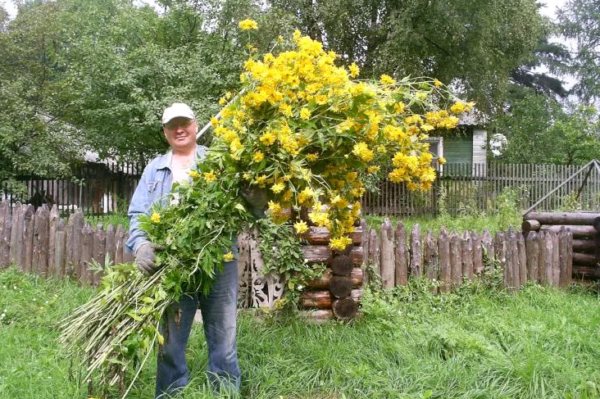

It is better to divide the root of the "Golden Ball" at the end of summer - in autumn, before the onset of frost on the soil:
- Cut off the entire bush so that 10-20 cm of the stem remains above the ground;
- The plant is dug up completely, the root is separated with a sharp knife or pruner;
- The main bush is planted in its original place, organic matter is added under the bush;
- A hole is prepared for a new root - 20-30 cm deep, a layer of sand (1-2 cm) and drainage (1-2) is poured onto the bottom so that after winter and snow melt, the roots do not rot. You can apply fertilizer in the form of manure or phosphorus-potassium fertilizer;
- The hole is sprinkled with soil, to which sawdust and wood ash are added;
- With the onset of constant frosts, the plant is covered with spruce branches, peat, hay or dry grass.
Legendary past
According to one of the eastern legends, a beautiful young man, the son of a vizier, fell in love with the sultana. For the sake of his beloved, the young man was ready for anything. She did not reciprocate and, in order to get rid of the courtship of the annoying young man, set a condition: he must get her the moon from the sky. Legend has it that a lover, late at night on a full moon, climbed onto the minaret, stretched out his arms to the moon and pulled it out of the sky. However, he could not maintain such a height and fell. The moon slipped out of his hands and again floated to the sky. Many of her reflections in the form of golden balls turned into beautiful yellow flowers that remind of unrequited and reckless love.
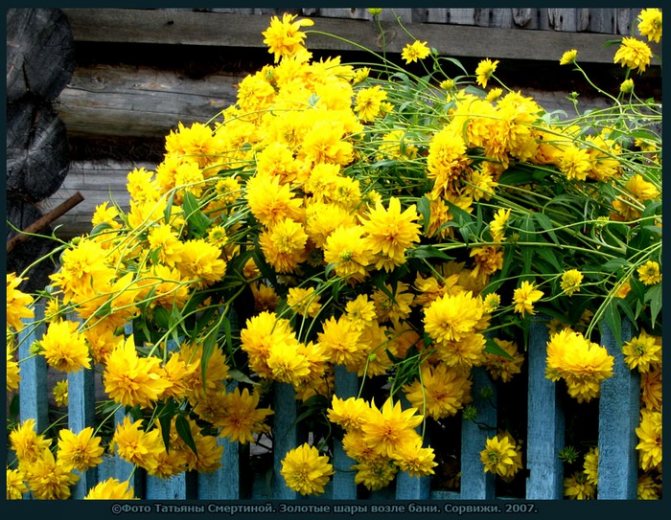

Believe it ...
In folk medicine, drugs are prepared from the roots of rudbeckia and its aerial part for the treatment of inflammation of the uterus, vaginitis, as well as prostatitis and impotence. The people believed that golden balls were a good talisman against treason, so earlier wives sewed several dry rudbeckia petals into the floors of their husbands' clothes. This plant in popular belief helped to improve family relationships. And it was also believed that with the help of golden balls you can attract money into the house.
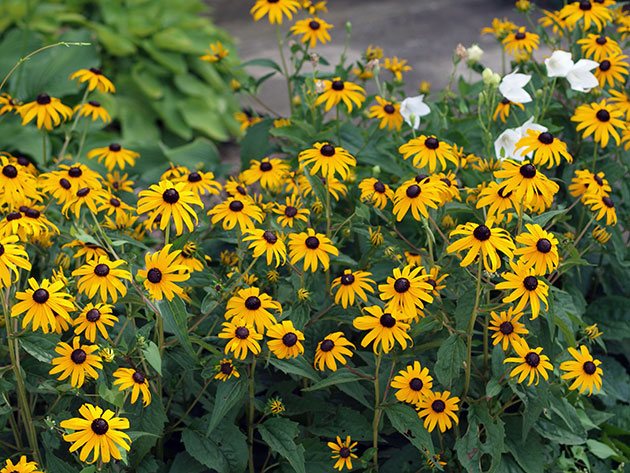

Description
What does rudbeckia look like? Flowers are located on straight, medium leafy stems from 25 cm high (for example, Maroccan Sun - 45 cm high or Toto Gold - 25 cm) to 3 m (for example, Herbssonne - 2 m high). A bush in diameter can be from 30 cm to one and a half meters. The stems are covered with hairs, branched or solitary. Baskets of inflorescences are rather large, from 8 to 15 cm, of combined saturated autumn colors (bright yellow, bright red, black). A feature that distinguishes rudbeckia from other representatives of the Astrov family is a convex receptacle, similar to a lump.
Ibsen throws a new piece to the masses
Brilliant revelation or poetic madness? The peculiarity of Ibsen's playmakers is that they do two performances, once when they appear in the book trade, and then when they win color and life on stage. Also Hedda Gubler, Ibsen's newest drama, seems to want to do this interesting double. It is already being discussed with all the passion in all German newspapers, as if we have already experienced another sensational premiere. While Ibsen's orthodox enthusiasts also exclaim this drama for the brilliant revelation of the Scandinavian poets, their opponents draw the most poignant conclusions about the intellectual development of the great playwright, and some are reluctant to deny Ibsen's poetic compliment.
Rudbeckia seeds are small, shiny, dark gray (see photo). They can be stored for 2-3 years, during this period they retain good germination.
Photo of the lower and upper leaves of rudbeckia.
But he looks with great satisfaction at the waves and the struggle with the spirits; where he also throws his sparks, everywhere he ignites a powerful movement in the literary world. He tosses a new piece to the masses and still has an irresistible pleasure as the drama breaks down into the smallest veins each month before a performance and is fragmented.
Dualism makes Austrian stomach pain
Hungarians want more independence - where will this lead? "What is dualism?" The question often arises. The slogan is in all the newspapers, and the kind Viennese citizen looks at him with amazed eyes. He grew up not knowing anything that is now baked on morning coffee, soup-pop, evening beer. He replied that dualism is still better than federalism, and that the lesser must be chosen between the two evils. But no one explains to him either one or the other of the salvation of the state in an understandable manner, but simply tells him that he should get rid of the wrong views of centralism, and not because of a small good, but always try something new, until we accidentally we can; that we will continue until we can go on and then have to return.
Rudbeckia is both a perennial and an annual. Theoretically, many varieties are perennials, but they are grown either as annuals or as biennial plants for several reasons: winter frosts - while the plant reproduces well and easily by seeds, thickening and aging of the bush
Landing order
A novice gardener who decided to plant yellow balls on his site needs to know all the possible methods and rules for planting this plant.
Reproduction and planting of rudbeckia can be carried out in the following ways:
Seedling method
For this option, the following conditions must be met:
Choose the right flower seeds
The period of implementation of this method falls on mid-March - early April;
- To begin with, do-it-yourself wooden containers for sowing seeds are made, or ready-made special seedling boxes are purchased in specialized stores;
- The boxes prepared and treated from pests are filled with soil substrate for seedlings;
- Small depressions are made in the soil into which the seeds are sown;
- Sprinkle a little earth on top of the seeds and moisten the soil with a sprayer;
- The seeded containers are covered with foil and left indoors. Where the air temperature will be at least twenty degrees Celsius;
- After a ten-day period, the first shoots should appear, when this happens, the film can be removed, and daily moistening of the soil should be carried out;
- When the second leaves appear on the seedlings, they need to be dived, thus, for young seedlings there will be more space for comfortable development;
- When the dive seedlings take root, they must be hardened. For this, the box with young plants is transferred to another room or to the street, where the air temperature should be from ten to fifteen degrees Celsius;
- At the end of May, the already grown sprouts of the golden ball are planted in open ground. If there is one hundred percent confidence in the absence of frost, then well-rooted seedlings can be planted earlier;
- When planting in open ground, it is necessary to maintain a distance outside of less than thirty centimeters between each plant;
- In the northern latitudes of Russia, the air warms up much later than in other regions of the country. Therefore, it is recommended to cover rudbeckia planted in open ground in the northern regions with agrospan or polyethylene until the plant is accepted.
- An appropriate place is selected on the beds, for sowing rudbeckia;
- Small grooves are made in the ground in which the seeds are placed;
- The sowing is covered with a small layer of fertile soil;
- With the help of a garden sprinkler, the sown area is moistened.
Read also: Statice growing from seeds: when to plant, at home
Direct way
It is often carried out in mid-June when the ground is warm enough.This method is characterized by the fact that it is not required to spend time and effort on growing seedlings, since the sowing of rudbeckia is carried out directly in the open ground. The disadvantage of this method is that the golden ball will bloom no earlier than next year. The procedure for planting seeds in open ground is similar to the previous method, and is the following sequence:
When and how to plant?
- Seedlings are planted in the ground in May, when constant heat is established without frost.
- Seedlings are taken out of containers together with an earthen clod and carefully lowered into the ground.
- The earth is compacted and watered abundantly.
- Plants reproduce well by self-sowing. Replanting seedlings depends on the climatic conditions of the region. The northern regions are engaged in planting in June. Middle strip of Russia in May. Southern regions at the end of April.
- Sometimes it is difficult to guess the weather conditions. Therefore, when planting, it is worth using agrofibre or any other protective material.
- The golden ball loves open, sunny areas.
- The flower is not picky about the soil, but it is better to prepare light and nutritious soils.
- Sawdust, sand, ash and compost must be added to clay soil. This will make it lighter and more nutritious.
- In poor soil, you can add compost, peat and humus and dig up the site.
The ways
- Seminal. Planting material can be purchased at any flower shop. Seedling germination lasts for 3 years. The grooves are prepared. The bottom is covered with ash and humus. Seedlings are planted to a depth of 4 cm, covered with light earth and watered. They are covered with a film from above.
- By dividing the bush. In early spring or late autumn, when new shoots appear, they are separated from the mother bush and planted in a new place.
- Seedlings. Seeds are planted at home for seedlings. In May, they are transplanted into open ground. If the planting material is bought in a store, you should pay attention to the appearance. The stem should be strong and not very elongated. There should be no yellow leaves. Do not abuse fertilizers during planting. If there is no rain after planting, the seedlings should be watered.
- Self seeding. When the fallen seeds germinate the following year, they are transplanted to a permanent place as soon as frost-free weather settles.
Rudbeckia, planting and care without hassle.
A flower that looks like the sun needs a lot of light. It can be planted in partial shade, but then the flowers will be smaller and will fade faster.
The plant is especially unpretentious to the soil, but it is still better to choose a fertile, light, moisture-permeable plant. In my front garden, in the sunniest place, there was clay soil, but the place was very suitable for planting these flowers. I added a bucket of peat and a bucket of compost per square meter, dug everything up well and it turned out to be a good flower bed for rudbeckia.
It should be planted in the spring, in our region in mid-May. Seedlings bloom earlier, although seeds can also be sown.
I place the seedling bushes 30 cm apart, planting them in shallow holes and sprinkling them with soil on top. I just press the seeds into the ground. At first, it is especially necessary to monitor watering so that the plants start well and grow.
This unpretentious flower reproduces well by dividing the bush. Carefully separate a part of the overgrown bush with a shovel, dig it up and transfer to a prepared place. In this case, the planting hole needs to be made larger so that the roots are free. In this way, flowers can be planted in spring and autumn, in September.
Rudbeckia care.
Although she is unpretentious, a little attention should still be paid to her. The plant loves moist soil, but it is not worth overfilling, as well as allowing it to dry out.
I tie the dissected rudbeckia (golden ball), otherwise the stems may break under the weight of the inflorescences. For the winter, I cut the bushes almost to the root. In winter, I cover it with snow, this flower is frost-hardy, but sometimes Siberian frosts can not stand.
If you are thinking about what flowers to plant in the spring in the garden, choose rudbeckia. You will definitely like the suns on high legs.
Rudbeckia: combination with other plants
The golden ball will delight you with beautiful flowering in one place for many years. In the open field, it is planted where the flower bed is not renewed every season. Its decorating properties are used for planting:
- near walls and fences;
- against the background of green corners, areas with tall shrubs;
- near benches and gazebos.
The golden ball looks great in combination with bouquet flowers. More often as an additional touch. In a solo version, a cut flower will retain its beauty in a vase for more than a week. Rudbeckia dissected is a good material for those who do not have the opportunity to spend a lot of time caring for a flower garden and decorating their site. The long flowering period and ease of cultivation have made the Golden Ball one of the most popular crops among domestic gardeners and summer residents.
Feeling warm
The period of Indian summer coincides with the flowering time of solar miraculous flowers, popularly called "golden balls". It is especially depressing to look out the window and see an overview of your own gray front garden, abundantly washed by rain. The best way to prolong the feeling of summer warmth in your soul is to plant bright, beautiful flowers that amaze with amazing freshness in a garden or vegetable garden. Among the most suitable "candidates" for this case are sunflower and marigolds, calendula and cinquefoil, clematis and chistyak. You can also highlight the golden ball - a flower endowed with an amazing natural magnetism that attracts the eyes of others. Its real name is "rudbeckia". He is quite simple and innocent in appearance, despite his attitude to the "Compositae" family. Such a flower with all its being reaches for the sun's rays, as if saying goodbye to the earth before the onset of cold and frost. This plant reaches a height of about fifty or two meters, its flowering continues until significant frosts.
Description
An amazingly beautiful golden ball is a flower that looks incredibly attractive on any territory of the land. it can be used to achieve a certain design style, visually eliminate flaws and highlight the best advantages of the garden. The owners prefer to plant rudbeckia near the fences of their land to a greater extent, creating an amazingly stylish decor. The arrangement of the petals surprises with its clarity and correctness, as if creating a visual path. The plant can even be planted behind other cultivated vegetation, which will allow you to create an original flower arrangement in the garden.
Reproduction
Quite simply and easily, the golden ball (flower) propagates by sowing seeds. Having cut the cuttings of the plant (both autumn and spring samples), it is necessary to plant them in a greenhouse, and then plant them in the ground in an open area. It should be noted the unpretentiousness of rudbeckia, which takes root and grows excellently on any soil. It does not perish and does not lose its visual appeal under the force of a shower. But it is not recommended to expose rudbeckia, which has taken root in a pot, in pouring rain, since in this case it is necessary to avoid high humidity.
Fertilizer
For the best growth and splendor of rudbeckia, you need to take care of its proper feeding. For this purpose, you can apply fertilizer, including green.Many other types of horticultural crops can coexist with this plant in full agreement, since it does not belong to the category of parasitizing or surviving other vegetation from the site on which it grows. To a greater extent, the golden ball is a flower that is very “friendly” with such representatives of flora as gypsophila, reed grass, vernonia, aster, aconite.
How to cover the golden balls (flowers)
The photo shows us how beautiful they are. One of the worthy qualities of rudbeckia is frost resistance, it can withstand a fairly low temperature. Winters without snow can be dangerous. In this case, you need to take care of the high-quality insulation of the flower. It is best to use humus, laying it in a layer of up to 5 cm. This "insulation" can be replaced with any other raw material or material. Recently, covering non-woven material is most often used for warming garden plants. In the absence of such, it is quite possible to create warmth for the root system of rudbeckia with the help of a plant such as spruce spruce branches. With its participation, it is easy to ensure snow retention on the surface. If the snow layer is located at a height of half a meter, you can not worry about freezing of rudbeckia, since its roots will be completely protected from frost. Any owner can buy a golden ball in a specialty store, and also find the best place for it to grow. This sunny plant will certainly adequately thank a person for their attention and care with the unforgettable warmth of its bright flowering.
Views
The genus rudbeckia has annual and perennial plants and is subdivided into types:
- rudbeckia dissected,
- glossy,
- shiny,
- hairy.
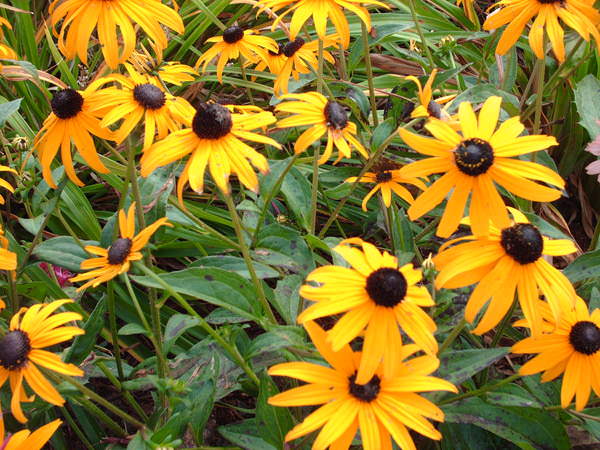

Hairy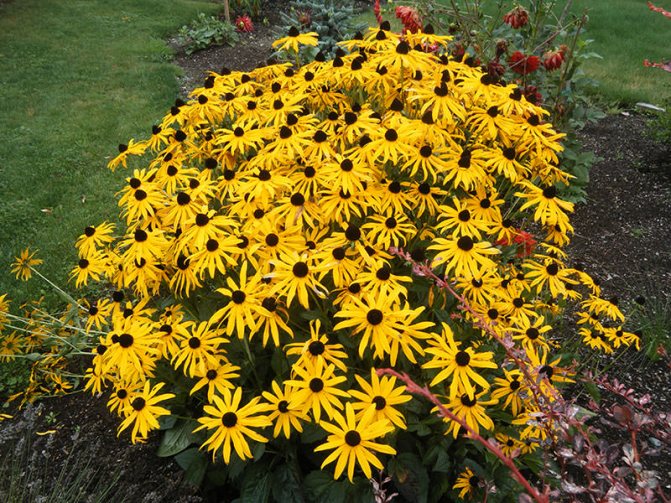

Shiny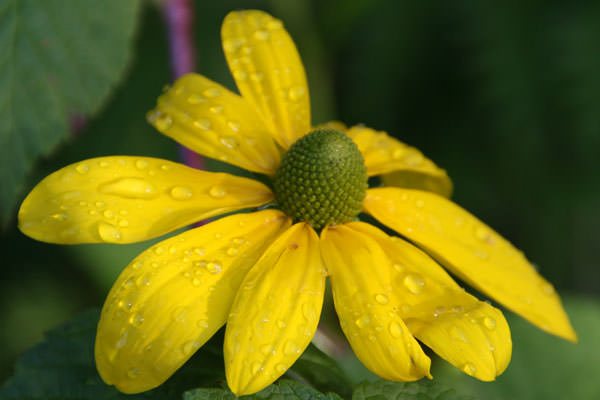

Glossy
All 4 species have been successfully used by scientists to create new varieties. Variety "Green ball", is the brainchild of dissected rudbeckia.
Taxonomy [edit | edit code]
Some sources combine this genus with the closely related genus Echinacea ( Echinacea
).
The genus is usually divided into three sections: Dracopis
,
Macrocline
and
Rudbeckia
.
First of all, cultural ornamental species are widely known.
Types [edit | edit code]
- Rudbeckia laciniataL.typus [2] - dissected rudbeckia - on the basis of which the famous decorative variety 'Golden ball' was obtained
- Rudbeckia nitida Nutt. - Rudbeckia glossy - served in the production of many hybrids
- Rudbeckia fulgidaAiton - Rudbeckia brilliant - served for obtaining many hybrids
- Rudbeckia heliopsidis Torr. & A.Gray - Rudbeckia sunshine [3] - almost never found in culture
- Rudbeckia hirta L. - Hairy rudbeckia - many decorative varieties are derived from this species, it is considered a symbol of Maryland since 1918
- Rudbeckia hirta var. pulcherrima Farw. [syn. Rudbeckia bicolor Nutt. - Rudbeckia two-color]
Botanical illustrations of some types of rudbeckia [edit | edit code]
From book "Illustrated Flora of the Northern States and Canada
"N. L. Britton and A. Brown (1913)
Rudbeckia is a fairly common flower. This is due to the fact that her flowers are very beautiful and she does not need special care. There are many varieties of this flower. Among them, the dissected rudbeckia stands out. She is very beautiful and looks harmonious next to other flowers. The most beautiful kind of dissected rudbeckia is the "Golden Ball", its other name is "Goldkwelle".
What care is needed for abundant and early flowering?
The main and important task of the gardener in caring for the "Golden Balls" is moderate watering, loosening the soil, cleaning weeds, fertilizing and preventing diseases and pests, supporting the plant.
- Watering should be moderate; in case of heavy rains, grooves are made from the plant to drain water. In dry weather, the flower is watered in the evening;
- Loosening and removal of weeds is carried out as needed, but preferably once a week;
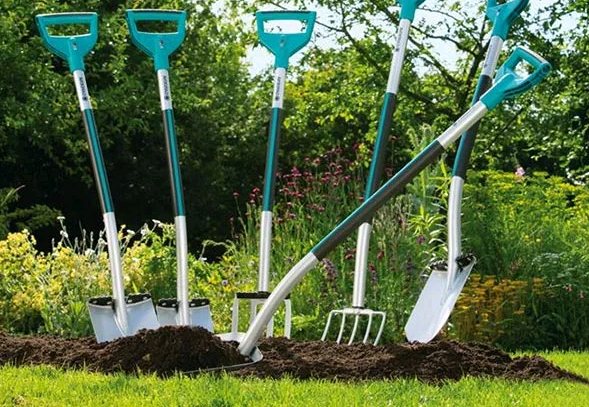

- Fertilizer. Carried out 3 times during the summer-autumn season:
- At the beginning of summer, phosphorus-potassium fertilizer is applied, as well as fertilizers containing iron, magnesium, calcium - for growth and abundant flowering;
- During the formation of buds, fertilizers are applied that contain potassium, boron, nitrogen, copper;
- In the autumn before frost - fertilizers containing nitrogen, sulfur, phosphorus, potassium are applied - which will increase the frost resistance of the plant.
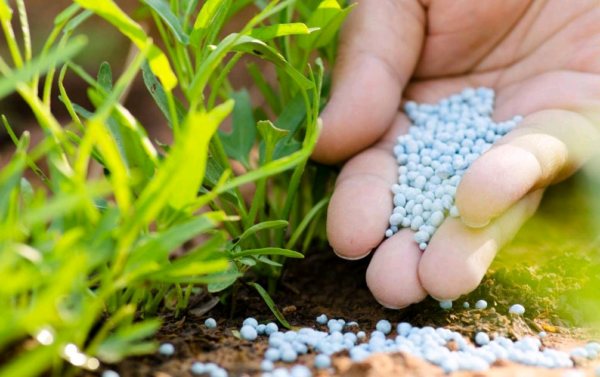

- The main pests and diseases of the Golden Ball flower are powdery mildew, caterpillars, spiders, nematodes. So that the plant does not hurt and does not become infected with pests, weeds and diseased plants on the site should be removed, and the soil should be treated in spring and autumn with a weak solution of manganese. If the plant is sick, then it is treated with a special remedy for diseases and pests;
- Supports and a garter of the plant should be carried out when its height reaches more than 1 m. To prevent a powerful, branched plant from breaking from rain and wind, it is better to tie it up with a soft rope to a support or nearby growing trees or to a fence.
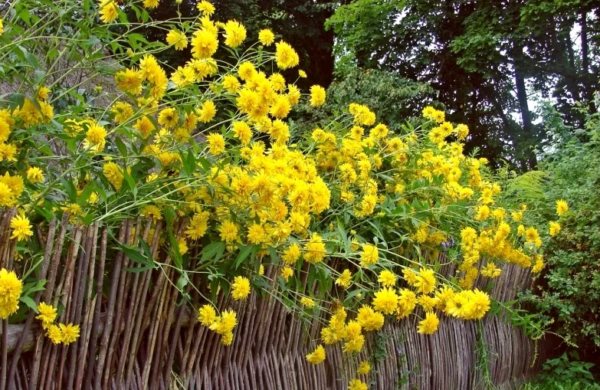

For comfortable growth, it is better to plant the Golden Balls next to asters, echinacea, craspedia, marigolds, phlox, verbena, delphinium, heliopsis. With such neighbors, it will be less likely that the plant will become infected with diseases and pests.
In the fall, after cutting the flowers and preparing the plant for winter, you can create a unique bouquet of rudbeckia that will stand in a vase for 1.5-2 weeks. The daily change of water and every three days pruning the limp edge of the stem with a sharp pruner will allow the bouquet to extend its life.
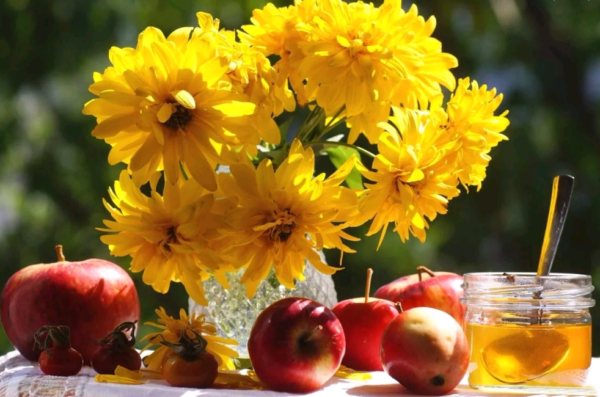

The flowers of the Golden Balls plant are used in folk medicine, although officially they do not belong to medicinal plants. Many gardeners use the flowers in decoctions to gargle and repair cracks in their arms and legs.
Types and varieties
Very often rudbeckia is confused with echinacea, we are asked - is it the same thing or not? We explain the difference between these two plants. It is echinacea that can be found on sale under the name rudbeckia purple or pink. Many varieties that are sold under the erroneous name of rudbeckia, such as "White Swan", are echinacea.
In the title photo, the Tiger Eye variety.
Rudbeckia and Echinacea are indeed very close. In the west, an extremely fashionable hybrid of these two plants even appeared - Echibeckia, no one has ever heard of such a plant in our country.


Echibeckia 'Summerina Brown Tuin'
Types of rudbeckia:
- Rudbeckia grasping (Rudbeckia amplexicaulis)
- an annual plant. - Rudbeckia dissected (Rudbeckia laciniata)
- it was this species that became the ancestor of the famous "Golden Ball" variety, whose name has even become a household name. - Rudbeckia lustrous (Rudbeckia nitida)
- another ancestor of the mass of hybrid varieties. - Rudbeckia brilliant (Rudbeckia fulgida)
- also became the "source" for many hybrids. - Rudbeckia heliopsidis
- a rare plant in culture. - Rudbeckia hairy (Rudbeckia hirta)
Is another species that gave birth to many modern varieties (for example, rudbeckia hirta Cherokee Sunset). It is one of the symbols of the state of Maryland (along with a white oak, a retriever dog, a Baltimore Oriole and four other symbols). - Rudbeckia bicolor (Rudbeckia bicolor)
- characteristic bicolor flowers.
Rudbeckia amplexicaulis
Photo of cut rudbeckia - Rudbeckia laciniata
Rudbeckia "Golden ball"
Rudbeckia nitida
Rudbeckia fulgida
Rudbeckia heliopsidis
Incomparable rudbeckia hairy (Rudbeckia hirta), photo of the charming cultivar 'Prairie Sun'
Rudbeckia bicolor
Perennial rudbeckia varieties
Terry:
- Goldquelle
(in Russia they call Goldkel) - terry golden abundant flowers-balls, plant height 80-100 cm, winter-hardy. - Maroccan sun
- flowers of different sunny shades, double, similar to chrysanthemum flowers, long flowering - from late June to frost, low bush - 45-50 cm. - Maya
- a medalist variety, an unusual combination of a compact bush (45 cm) and densely double spherical inflorescences of bright yellow color (diameter 9-12 cm).
Rudbeckia laciniata `Goldquelle`
Maroccan Sun variety
In the photo, rudbeckia Hirta Maya (Maya)
Non-double:
- Herbssonne
- simple yellow flowers, very tall (up to 2 m) bush. In Russia this variety is called "Herbszonne". - Black Beauty
- an exotic variety. There are no reed petals, the flowers are, in fact, black cones, looks great in compositions, the height is 120-150 cm. - Toto Gold
- a low, even dwarf (25-30 cm) container plant with simple sunny flowers 5-7 cm. It grows well in pots, suitable for balconies, terraces. In general, Toto is a series of undersized varieties, very similar and differing only in color. - Toto Rustic
- a plant with a height of 30 cm, flowers are large, red-yellow, with a brown center, very showy, like flashes of flame.We often call this variety simply - rustic. - Moreno
- unusual color of petals, very deep velvet red. Chocolate core with bright yellow anthers. The flowers are large - 15 cm in diameter. The height of the plant is average - about 65 cm. This is a variety of hairy (sometimes also called shaggy) rudbeckia. - Irish eyes
- tall plant 75 cm, flowers - 10 cm, yellow-orange, wide petals. Feature - light centers with a button. - Gold sturm
- flying flowers (12 cm in diameter), with very expressive spherical almost black centers, bush 60 cm high. Abundant flowering, flowering plant looks like a cloud of exotic bees. - Denver daisy
- bush height 90 cm. Flowers - chamomile, two-colored, excellent variety for cutting. - Сherry brandy
- low abundant flowering plants, cherry flowers. - Cordoba
- compact bushes, two-colored bright glowing flowers (dark red and yellow). Height 45-60 cm, suitable for container growing. - Henry eilers
- rudbeckia with the narrowest petals, flowers are pure yellow, without a golden hue, bush 1, 5 m. Valued for grace and delicacy.
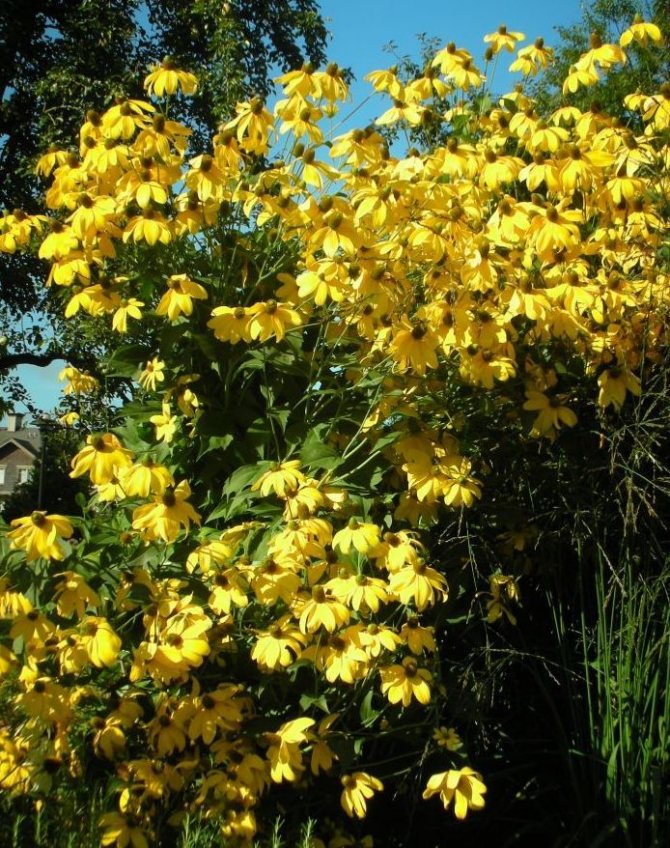

Pictured is Toto Mix, on the left is Toto Gold.
Variety Moreno (Moreno), the photo does not quite accurately convey the red tint - such velvety deep tones are quite difficult to photograph.
Rudbeckia brilliant, grade Goldsturm
‘Denver Daisy’ variety
Rudbeckia 'Cordoba'
Henry eilers grade
Title [edit | edit code]
The first settlers of North America, paying attention to beautiful flowers, introduced the plant into culture as a decorative one and gave it the poetic name "Black-eyed Suzanne" [ source not specified 568 days
] (English Black-eyed Susan), because of the dark colored cores of the inflorescences. After a while, the seeds came to Europe, where the plant was further spread. The shape of the inflorescence-basket, apparently, determined the popular German name - "Sun hat" (German Leuchtender Sonnenhut).
The modern scientific name of the genus was given by Karl Linnaeus in honor of the Swedish botanists, the father of Olof Rudbek the elder and the son of Olof Rudbek the younger, the latter was a friend and teacher of Linnaeus at the University of Uppsala.
Linnaeus's words [ source not specified 568 days
] about the name of the new taxon, addressed to Rudbek:
Great Rudbek! To perpetuate the glory of your name, I called it "Rudbeckia", according to the power of all botanists and, therefore, granted to me. It should make your name immortal and speak about it before kings and princes, before botanists and doctors, before all people, so that if the whole world falls silent, then Rudbek's plants will speak about it until nature passes.
Gardeners sometimes use a different spelling of the genus name in Russian - “Rudbeckia
". For example, the name is often used
Rudbeckia purple
to designate the plant Echinacea purpurea from another closely related genus - Echinacea.
Description [edit | edit code]
The stems are simple or branched, the height of the plant is from 50 cm to 3 meters (in some species).
Leaves 5 to 25 cm long, whole or pinnately-divided, sometimes pinnately dissected, oval or ovoid. In the upper part of the stem, the leaves are sessile, in the lower part they are long-petiolar.
Inflorescences are large baskets up to 15 cm in diameter. Receptacle strongly convex, later cylindrical, with filmy sharp bracts.
The marginal flowers are sterile ligulate yellow or orange, the middle ones are tubular bisexual from yellow to purple-black or brown.
The fruit is an oblong achene, sometimes with a small crown.
Botanical view of the plant
The golden ball is a perennial herb, the height of which reaches three or more meters. But the most common types of rudbeckia are bushes no more than seventy centimeters high. The root system of such a plant is fibrous, with a horizontal and sufficiently branched rhizome, which contributes to the formation of a number of new young shoots.
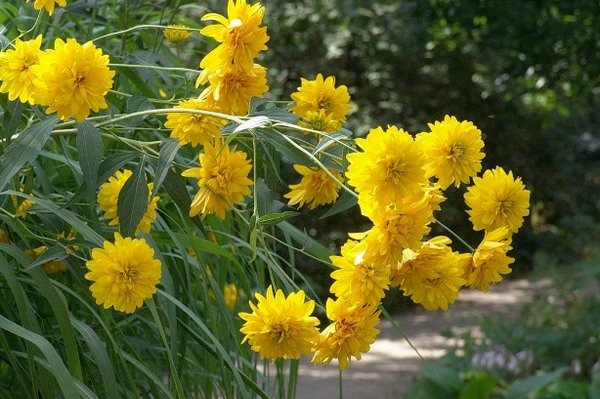

The trunk of the rudbeckia is simple and branched, round in section and dirty green in color. The sheet is divided into several parts, which are oval in shape and are characterized by jagged edges. Depending on the type and age of the plant, the leaf length ranges from five to twenty-five centimeters. The main accumulation of the deciduous crown falls on the lower part of the plant, therefore, the golden tops are decorated with exclusively yellow flowers. The outer part of the leaf is smooth, dark green in color. As for the inner part of the leaf, it has a pale green hue and has a slight hairiness.
The stem of the flower has a complex or simple inflorescence at the end, with very large baskets (usually their diameter is about ten centimeters). The pedicel is convex, which, after a certain period of time, acquires the bracts of a cylindrical shape. The blossoming flower has a bright yellow-orange color.
The golden ball begins to bloom in mid-July, and continues until mid-autumn. After flowering, seeds are formed, which are presented in the form of a crown with small teeth.
In our material, we will tell you how to plant a hydrangea and care for it.
Here we will tell you in detail about growing a climbing rose.
How to plant and care for lavender? Read about it here.

